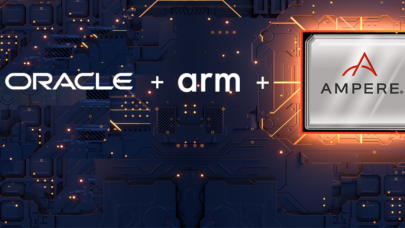
Amazon Saw Arm Server Chips Coming in 2009
August 31, 2022
The Arm chip architecture took the mobile world by storm in 2007 after the release of the first iPhone. Just two years later, an Amazon executive who now leads the company’s semiconductor development, believed Arm would eventually be a big part of server-side computing. “I’ve observed, over the years what happens in mobile ends up happening in servers. Read more…

Microsoft Rolls Out Ampere Altra Arm CPUs in Azure
April 5, 2022
There was a time when “the cloud” ran on pretty vanilla x86 architecture, save for boutique firms like Nimbix (acquired by Atos last year) that pioneered the use of then-exotic hardware like GPUs and FPGAs and other Intel alternatives. If further evidence was needed of the... Read more…

OCI Jumps into Arm with Instances and Aggressive Developer Program
May 25, 2021
Oracle Cloud Infrastructure (OCI) today launched a multi-prong Arm initiative including instances (VM and bare metal) based on Ampere’s Altra microprocessor, Read more…

Nvidia Opens GTC with Plans for AI Supercomputer for Biomedical Research
October 5, 2020
Given the COVID-19 pandemic, Nvidia’s announcement of plans to build a new AI supercomputer – Cambridge-1 – dedicated to biomedical research and healthcare was perhaps the most significant HPC news coming from fall GTC which began today. The new system, to be located in the U.K., will deliver more than 400 petaflops of AI performance, according to Nvidia... Read more…

University of Florida to Deploy World-Class AI Supercomputer
July 21, 2020
The University of Florida announced it will stand up a state-of-the-art AI supercomputer, powered by the latest Nvidia technology, to tackle major challenges su Read more…

Google Cloud Debuts 16-GPU Ampere A100 Instances
July 7, 2020
On the heels of the Nvidia’s Ampere A100 GPU launch in May, Google Cloud is announcing alpha availability of the A100 “Accelerator Optimized” VM A2 instance family on Google Compute Engine. The instances are powered by the HGX A100 16-GPU platform, which combines two HGX A100 8-GPU baseboards using... Read more…

AMD Epyc Rome Picked for New Nvidia DGX, but HGX Preserves Intel Option
May 19, 2020
AMD continues to make inroads into the datacenter with its second-generation Epyc "Rome" processor, which last week scored a win with Nvidia's announcement that Read more…

Nvidia Expands Clara Healthcare Platform to Combat COVID
May 14, 2020
A new set of AI models released by the U.S. National Institutes of Health (NIH) in collaboration with Nvidia is designed to help clinicians detect and examine n Read more…

- Click Here for More Headlines

Whitepaper
Transforming Industrial and Automotive Manufacturing
In this era, expansion in digital infrastructure capacity is inevitable. Parallel to this, climate change consciousness is also rising, making sustainability a mandatory part of the organization’s functioning. As computing workloads such as AI and HPC continue to surge, so does the energy consumption, posing environmental woes. IT departments within organizations have a crucial role in combating this challenge. They can significantly drive sustainable practices by influencing newer technologies and process adoption that aid in mitigating the effects of climate change.
While buying more sustainable IT solutions is an option, partnering with IT solutions providers, such and Lenovo and Intel, who are committed to sustainability and aiding customers in executing sustainability strategies is likely to be more impactful.
Learn how Lenovo and Intel, through their partnership, are strongly positioned to address this need with their innovations driving energy efficiency and environmental stewardship.
Download Now
Sponsored by Lenovo
Whitepaper
How Direct Liquid Cooling Improves Data Center Energy Efficiency
Data centers are experiencing increasing power consumption, space constraints and cooling demands due to the unprecedented computing power required by today’s chips and servers. HVAC cooling systems consume approximately 40% of a data center’s electricity. These systems traditionally use air conditioning, air handling and fans to cool the data center facility and IT equipment, ultimately resulting in high energy consumption and high carbon emissions. Data centers are moving to direct liquid cooled (DLC) systems to improve cooling efficiency thus lowering their PUE, operating expenses (OPEX) and carbon footprint.
This paper describes how CoolIT Systems (CoolIT) meets the need for improved energy efficiency in data centers and includes case studies that show how CoolIT’s DLC solutions improve energy efficiency, increase rack density, lower OPEX, and enable sustainability programs. CoolIT is the global market and innovation leader in scalable DLC solutions for the world’s most demanding computing environments. CoolIT’s end-to-end solutions meet the rising demand in cooling and the rising demand for energy efficiency.
Download Now
Sponsored by CoolIT
Advanced Scale Career Development & Workforce Enhancement Center
Featured Advanced Scale Jobs:
HPCwire Resource Library
HPCwire Product Showcase
© 2024 HPCwire. All Rights Reserved. A Tabor Communications Publication
HPCwire is a registered trademark of Tabor Communications, Inc. Use of this site is governed by our Terms of Use and Privacy Policy.
Reproduction in whole or in part in any form or medium without express written permission of Tabor Communications, Inc. is prohibited.
























